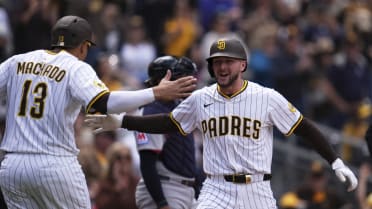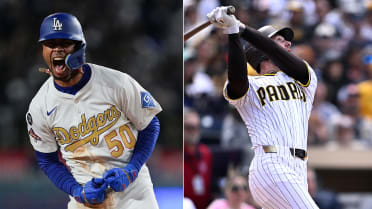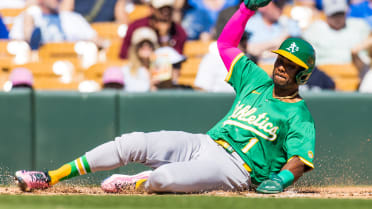"School of Rickey" opens with an Oakland graffiti artist named Vogue spray-painting a mural of Rickey Henderson: the young Man of Steal in his A's uniform, grinning as the city glints in the reflection of his sunglasses.
The documentary, presented by MLB Network, aired Tuesday night. It chronicles the stolen-base king's Hall of Fame career, but more importantly focuses on Henderson's unique style, emblematic of his home city. "School of Rickey" portrays the Oakland product as a trailblazing player-entertainer who helped transition baseball from Old School to New School.
"We were trying to balance the cultural impact, his legacy, why he matters now, while also touching upon his career," said MLB Network coordinating producer Jed Tuminaro. "He was a player sort of ahead of his era, and his impact, you can see it in a lot of what goes on in today's game -- the way Rickey played, the style, the flair he had. We set out to show that."
Through interviews with media members, Henderson's contemporaries -- like A's teammates Dennis Eckersley and Dave Stewart and manager Tony La Russa -- and current players like Josh Donaldson, Bryce Harper and Jimmy Rollins, "School of Rickey" looks to bridge the generational gap and highlight Henderson's continuing influence.
"Rickey was certainly one of those guys, when we did all these interviews, that you could tell transcended his era," Tuminaro said. "One thing I came away with thinking was how many people he really made an impression on. ... These players today know all about Rickey."
Rollins, as he recollects in the documentary, grew up in Oakland watching Henderson play. Donaldson and Harper aren't from the same city, but their emotion and celebrations while playing the game hark back to Henderson. Henderson's showmanship and flair, "School of Rickey" notes, emerged from the city of Oakland.
"He was Oakland," Rollins says in the film. "I don't know how I can say it any better. He was Oakland."
Henderson's connection to his city and its people is a constant thread in "School of Rickey," which interviews not only ballplayers but also Oakland street artists and rapper Too Short.
"So much of what Rickey was as a player was from where he came from," Tuminaro said. "No matter what the profession, be it entertainment, art, sports, people came to take on the vibe of the city of Oakland -- which is part rebellious, a little tough, some swagger, and all that added up. And that was all embodied in how Rickey Henderson played throughout his career."
The artists of the TDK Collective who painted the mural of Henderson, which serves as a recurring visual framework through the documentary, were themselves inspired by Henderson -- the loudness of their color, the style of their designs.
"The mural makes you stop and look and say, 'That looks like nothing I've seen on TV,'" Tuminaro said. "When you watch Rickey Henderson play, you look at him and say, 'He doesn't look like anything I see on TV.'"
Henderson, with his flash and strong personality, was sometimes seen as selfish or disrespectful, as are players who display similar behavior today. ("School of Rickey" uses Goose Gossage's criticism of José Bautista's bat flip in the 2015 postseason as an example.) But as the film depicts, Henderson's teammates didn't see him that way, and kids like Rollins idolized him -- for his talent, charisma and everything else that he was.
In the documentary, Rollins finally tries to capture Henderson's identity in the simplest terms: "Rickey was Rickey."
David Adler is a reporter for MLB.com. Follow him on Twitter at @_dadler.



